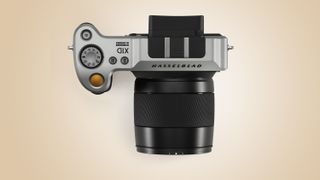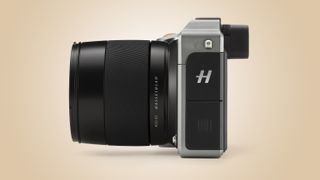Why you can trust TechRadar
Build and handling
- Milled aluminium body
- Excellent digital spirit level
- 725g
The Hasselblad X1D may be comparatively small, but it’s still a solid and hefty camera, and although the body is impressively light at well under a kilogram, the lenses are pretty substantial and do push the weight up.
This is one of the few cameras, though, with enough height in the grip to let you get all four fingers of your right hand around it, instead of leaving one dangling at the bottom.
The controls are really good. There aren’t many of them, but everything you need is here. The mode dial has an interesting action – to lock it, you press downward against spring pressure until it locks flush with the camera top plate. To change the mode, you press it again to release it and it springs up. It’s a neat idea, although perhaps the dial could do with being a little larger.

The touchscreen interface is responsive, and very clear, and there's an excellent digital spirit level, which displays a solid circular ‘bubble’ along a horizontal and vertical axis on the screen. It’s both more intuitive and much more responsive than we’re used to seeing.
A pair of buttons on the top plate offer quick access to auto/manual focus modes, ISO and white balance, and there’s a depth of field preview button on the front. On the back there’s an AE-L (exposure lock) button and an AF-D button for activating the autofocus – effectively, ‘back button focusing’ – although the autofocus can also be initiated by half-pressing the shutter release in the normal way.

There are some quirks. You could spend a long time looking for the full-size JPEG option, not realising there isn’t one. Hasselblad cameras only offer quarter-size JPEGs for quick reference or sharing, although we were told a full-size JPEG option was being considered for the X1D.
It’s also inconsistent in the way it handles shutter speeds. Initially, we thought it didn’t offer shutter speeds longer than 1 second in manual mode. In fact, as you turn the dial it goes from 1 second to the B and T exposure settings, and then past those into the longer exposure times. In shutter priority mode, the shutter speeds follow the normal sequence, with the B and T settings at the end.
Hasselblad has just introduced a v1.15 firmware update, which adds focus peaking, GPS support, maximum/minimum values for the Auto ISO option and the ability to specify a different exposure simulation on/off setting for manual mode, typically for use in studio flash photography.

The battery arrangement on the Hasselblad X1D is especially interesting. For a start, there's no door to the battery compartment. Instead, the base of the battery sits flush with the base of the camera to provide its own ‘door’. When you flick the battery release lever on the base of the camera the battery pops out a short distance, but no further – you then have to push the battery against spring pressure to release the catch fully.
There's also no battery charger. Instead, you plug the charging adaptor directly into the battery. It might sound like change for change’s sake, but it seems to echo the X1D’s style – fewer parts, less fuss.
Current page: Build and handling
Prev Page Introduction and key features Next Page Performance and image quality
